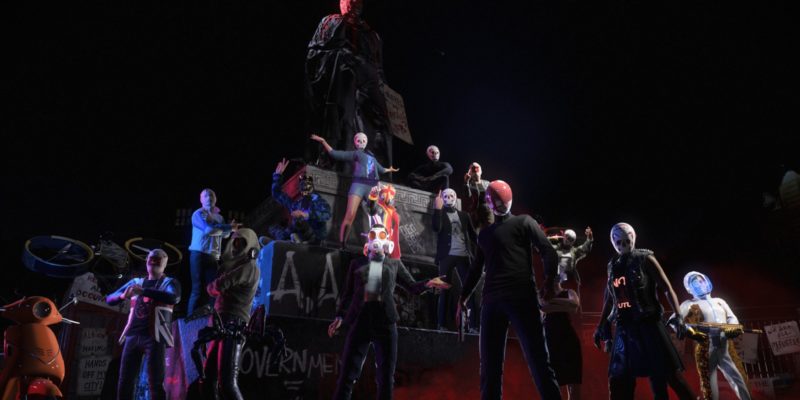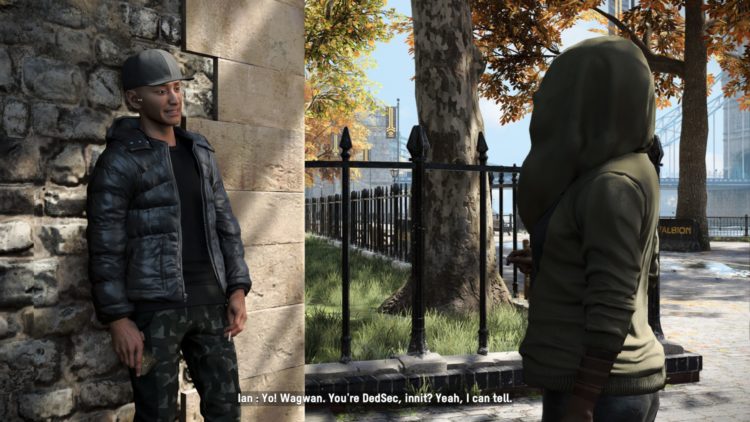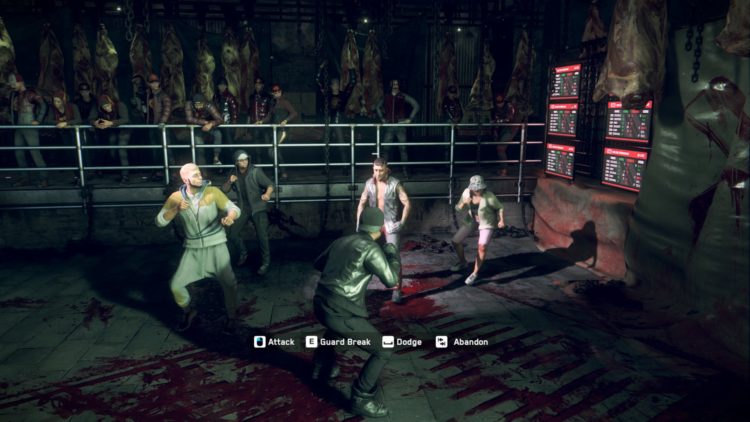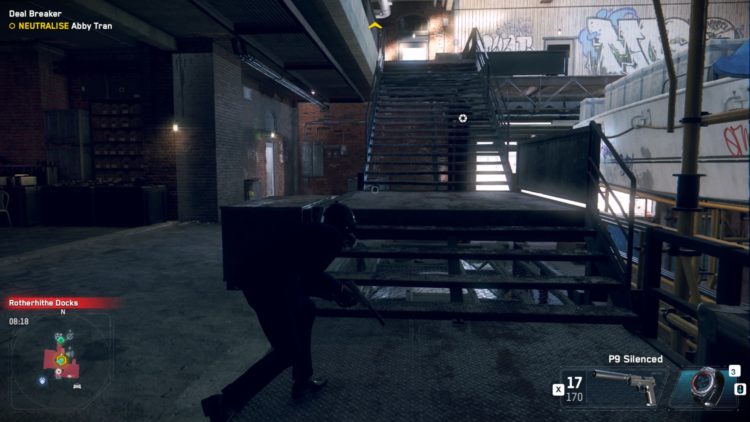
Fittingly for the spookiest month of the year, Watch Dogs: Legion worried me. Ubisoft tends to need to iterate to make its new and bold ideas work. The first version (Assassin’s Creed, Watch Dogs, The Crew…) shows off the idea. The sequel builds it into an actual game, and gives us what we should’ve had the first time around.
With Watch Dogs: Legion promising a world in which you can recruit literally anyone, it’s fair to say I was expecting to go “Nice idea, and I can’t wait for the sequel where it actually works.” So here’s the biggest shock of October: it bloody works. And for the most part, it works really, really well. It also helps to craft something that feels more like a living world than many of its competitors have managed.
London Calling
Near-future London is not a pleasant place to be. Several simultaneous terrorist bombings by the mysterious Zero-Day group have been pinned on our plucky hacktivist protagonists DedSec. And things are not looking good: the government is weakened, a PMC called Albion is “disappearing” dissidents and has effectively declared martial law on the streets, DedSec is in ruins, and rights of all kinds are being eroded.
(Although arguably, bits of it are actually preferable to how London was when I lived there. No-one threatened to stab me in the middle of a crowded shopping street at midday in Fictional London, for instance, which is more than I can say for Real London.)

Yep. It’s London.
It’s also a city that, to paraphrase the game, has taken 1984 less as a stark warning and more as a guidebook. Camera-equipped drones are ubiquitous, Albion checkpoints are everywhere, and any troublemakers rapidly disappear. Not only that, but everyone’s equipped with a smart device that records pretty much everything about them. Still, it’s also a city of the future! Auto-driving cars are everywhere and through some sort of sorcery, crypto is the de facto currency.
So, in this grim (and yet surprisingly sunny) city of the near-future, it’s up to you to restart DedSec London, uncover these abuses of power, and rally the occupied city towards freedom. Yes, you. Whoever you are. Whoever you want to be.

Melee combat is an entirely viable option. Most enemies will engage in melee by default if you don’t have a gun out — but if you don’t take them down fast enough, they may escalate.
Its name is Watch Dogs: Legion, for you are many
The Big Thing about Watch Dogs: Legion isn’t the setting or the story. It’s the fact that every single person you see on the street can be your newest operative, and I do mean everyone. The person protesting outside the tube station? You can sign them up. The guy flying drones in the park? They can be a member of DedSec London. The guy who just gave you a mission? Sure. And, yes, even the Albion grunt harassing an innocent passer-by can be convinced to sign up.
Each and every one of these people has their own unique perks, which run a marathon from tremendously useful to horrendously bad, with a brief stop off for a drink at the pub of totally pointless. That elderly lady might have access to a silenced sub-machine gun (because she worked on gun restorations), but because she’s old, she can’t sprint or take cover. That fashion model worked her way up the chain with hacking, and she can bust out dance moves, but she also likes to gamble your currency.
That’s cool enough on its own, but making it cooler is that they’re all voiced. These aren’t silent protagonists in cutscenes: there are a variety of voices and accents for both male and female characters. I had a particular fondness for my rather posh bare-knuckle brawler, my chirpy female amateur hitman, and my assault rifle-toting East Ender. And while cutscenes and conversations play out the same way, their unique dialogue makes things feel surprisingly unique.

Taking this guy down will make Megan Gaal much fonder of us, and may make her sign up on the spot.
They’re also all linked to other people in the city. Ambling around, you might be informed that the person you walked by is the uncle of someone you’ve tagged as a potential recruit. Or their boyfriend, or husband, or dealer. Or perhaps it’s someone they hate — a rival or harasser. Helping their friends out or dealing with their foes will improve their opinion of DedSec and may convince them to sign up. And all of these people have their own individual schedules that you can look at.
This, really, is what makes it feel like a living city: you’ll bump into a woman who hates you because, when doing a mission, you drove through a crowd and hit someone. That person was their husband. The wife now hates you and cannot be recruited by any means. She may even try to impede your future efforts or hunt you down. It’s not super fleshed out, but it gives a real feeling that your actions have an impact and that everyone in this city has a life. I can’t gush enough about how much I adore this.

This conversation would play out differently with different characters, but they still only really have the personalities I give them.
Going Underground
This is by far and away the single best thing about Watch Dogs: Legion, and it works tremendously well. That said, I do wish there was a bit more to the characters in more ways than one. While Watch Dogs 2 has a pretty well-fleshed out cast, this has your random characters (who have personality but not personalities) and… a bare minimum of other interesting people. The best of the lot is Bagley, your unbelievably snarky mission control AI. Beyond that, most characters are a wee bit uninteresting.
I also wish there was some form of character progression, but no. You can find Tech Points scattered around London and use these to unlock upgrades across the board — better weapons, or the ability to hack more things — but your characters themselves never grow. The operative you choose at the start of the game will have the exact same perks 20 hours later, even if you play as nobody but them. It would’ve been nice to see these characters “level up” individually (in both positive and negative ways, perhaps getting some downsides if they get hospitalized or arrested a lot) and not just with abilities that apply to your whole team.
Equally, characters are very limited in what they can equip. You’re limited to one gadget at a time, and the spiderbot is frankly too useful to not use most of the time. Especially because it’s outright required to reach a large number of the Tech Points and other collectibles. This means that the more insane stuff like dive-bombing drones or the ELECTROFIST are, alas, left by the wayside. Still, at least you can play as a character who attacks people with robot bees.

Ah, yes. Dilapidated industrial warehouse #6. My favorite location.
No Surprises
Watch Dogs 2 deserves to be brought up as a comparison again, actually, but this time in mission design. That game had brilliant missions and played with its mechanics a lot. There was driving the not-Knight Rider car, with your teammates making you think it had a working AI. You had that bit where you broke into a not-Scientology compound to rescue a movie star. And, of course, there was the giant spider-mech rampage while The Prodigy blasted away in your ears. Watch Dogs: Legion has… not much of that.
About 80% of the missions in the game boil down to examining a thing, going to a restricted location that is probably a building site or an office, breaking in with stealth or gunplay (which are both decent enough, but not great), and hacking a thing. The Borough Freedom missions (this is a Ubisoft game; of course you free areas, even if there are no radio towers) are vastly more entertaining, but the main questline is fairly flavorless and repetitious. The exceptions, ironically, are some that are too good to spoil, but I will say there are nice takes on James Bond tropes. I mean, one of the specialist characters is a spy, complete with a car that has a cloaking device and rockets. Of course this plays with British Intelligence.

While my fear of spiders was mostly relegated to regular ones, Watch Dogs: Legion has now made me terrified of six-legged robot ones with cloaking devices that latch onto your face and shock you with electricity.
Bitter Sweet Symphony
Really, Watch Dogs: Legion is a make-your-own-fun game. There aren’t many in-depth side activities to occupy you: no races or AR, for instance. Mostly darts and drinking. It’s very, very easy to bypass a lot of things: you can use cargo drones to fly directly to an objective half the time or send your spiderbot through vents to clear the path. If you do this, it’s easy and extremely repetitious.
If you don’t — if you really explore the possibilities — then, more often than not, you might just end up surprised and delighted. The multiple protagonist approach means you can sometimes succeed in missions by failing them; a post-mission ambush might end in your survival, or your protagonist being arrested. Hell, some missions can be completed by recruiting someone you’re meant to be dealing with in another way, and the game not only anticipates this, but it has unique dialogue for it.
It’s not as dour and sour-faced as Watch Dogs, which was the digital equivalent of a man chewing on a weapons-grade lemon, but it also lacks the chaotic and anarchic fun of Watch Dogs 2. Watch Dogs: Legion sits somewhere in between: occupied London isn’t quite the colorful hub of San Francisco, but there’s plenty of ludicrous stuff to explore and enjoy. Just make sure you take your time to do so.
The connected, living world here is a genuine revelation, and it’s well worth exploring if you’re willing to mess around and make your own fun. It’s just a shame that some of the vibrancy and depth of Watch Dogs 2 has been lost in the process.







More Stories
Doom Eternal review
Review: The Last of Us Part II complicates the idea of right and wrong
Dirt 5 review